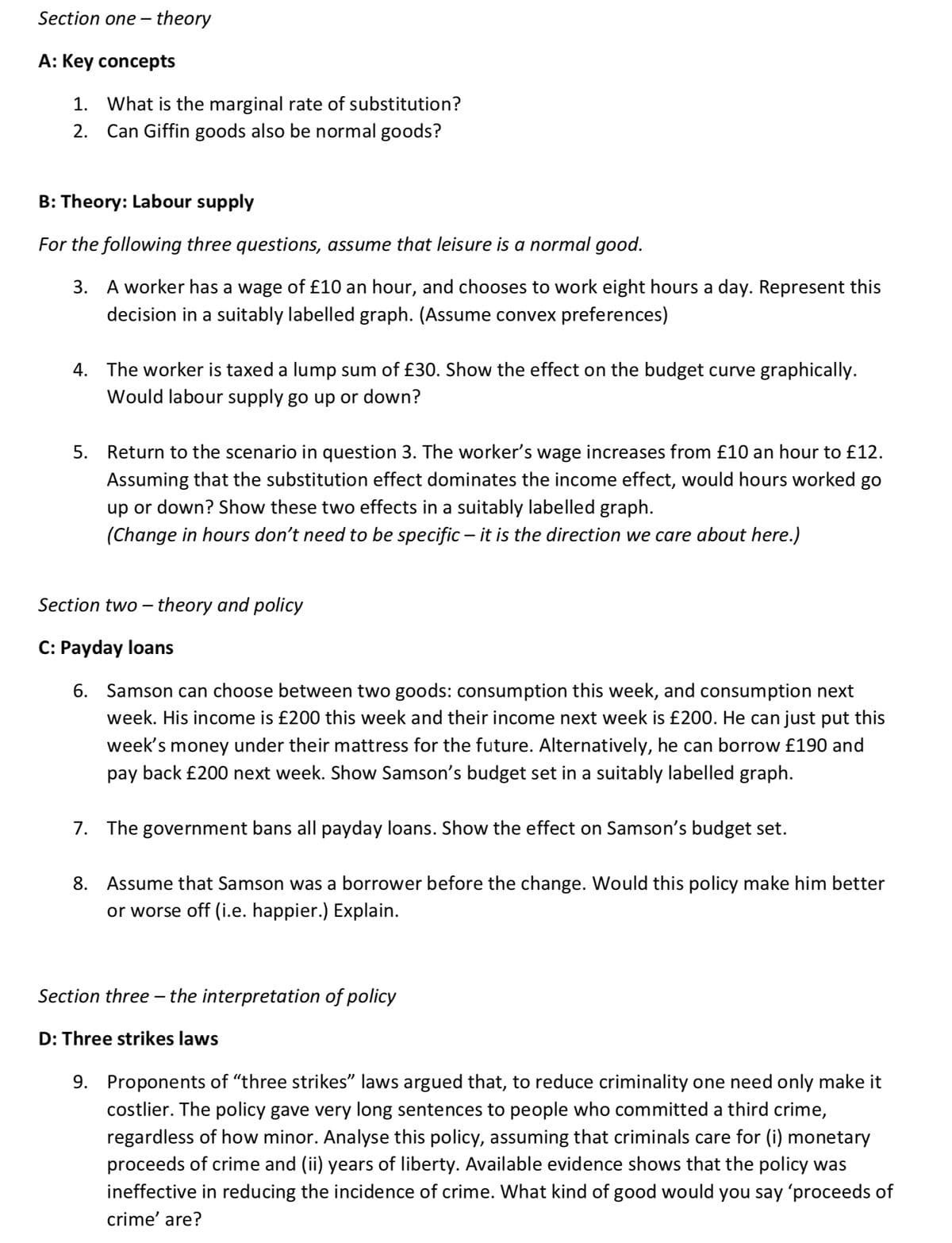3. A worker has a wage of £10 an hour, and chooses to work eight hours a day. Represent this decision in a suitably labelled graph. (Assume convex preferences)
3. A worker has a wage of £10 an hour, and chooses to work eight hours a day. Represent this decision in a suitably labelled graph. (Assume convex preferences)
Chapter16: Labor Markets
Section: Chapter Questions
Problem 16.10P
Related questions
Question
PLEASE ANSWER QUESTION 3

Transcribed Image Text:Section one-theory
A: Key concepts
1. What is the marginal rate of substitution?
2. Can Giffin goods also be normal goods?
B: Theory: Labour supply
For the following three questions, assume that leisure is a normal good.
3. A worker has a wage of £10 an hour, and chooses to work eight hours a day. Represent this
decision in a suitably labelled graph. (Assume convex preferences)
4. The worker is taxed a lump sum of £30. Show the effect on the budget curve graphically.
Would labour supply go up or down?
5. Return to the scenario in question 3. The worker's wage increases from £10 an hour to £12.
Assuming that the substitution effect dominates the income effect, would hours worked go
up or down? Show these two effects in a suitably labelled graph.
(Change in hours don't need to be specific – it is the direction we care about here.)
Section two-theory and policy
C: Payday loans
6. Samson can choose between two goods: consumption this week, and consumption next
week. His income is £200 this week and their income next week is £200. He can just put this
week's money under their mattress for the future. Alternatively, he can borrow £190 and
pay back £200 next week. Show Samson's budget set in a suitably labelled graph.
7. The government bans all payday loans. Show the effect on Samson's budget set.
8. Assume that Samson was a borrower before the change. Would this policy make him better
or worse off (i.e. happier.) Explain.
Section three - the interpretation of policy
D: Three strikes laws
9. Proponents of "three strikes" laws argued that, to reduce criminality one need only make it
costlier. The policy gave very long sentences to people who committed a third crime,
regardless of how minor. Analyse this policy, assuming that criminals care for (i) monetary
proceeds of crime and (ii) years of liberty. Available evidence shows that the policy was
ineffective in reducing the incidence of crime. What kind of good would you say 'proceeds of
crime' are?
Expert Solution
This question has been solved!
Explore an expertly crafted, step-by-step solution for a thorough understanding of key concepts.
Step by step
Solved in 2 steps with 1 images

Knowledge Booster
Learn more about
Need a deep-dive on the concept behind this application? Look no further. Learn more about this topic, economics and related others by exploring similar questions and additional content below.Recommended textbooks for you



Principles of Economics, 7th Edition (MindTap Cou…
Economics
ISBN:
9781285165875
Author:
N. Gregory Mankiw
Publisher:
Cengage Learning



Principles of Economics, 7th Edition (MindTap Cou…
Economics
ISBN:
9781285165875
Author:
N. Gregory Mankiw
Publisher:
Cengage Learning

Principles of Economics (MindTap Course List)
Economics
ISBN:
9781305585126
Author:
N. Gregory Mankiw
Publisher:
Cengage Learning

Principles of Microeconomics (MindTap Course List)
Economics
ISBN:
9781305971493
Author:
N. Gregory Mankiw
Publisher:
Cengage Learning
